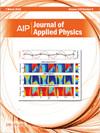具有良好玻璃成型能力和性能的金属玻璃的逆向设计机器学习模型
IF 2.7
3区 物理与天体物理
Q2 PHYSICS, APPLIED
引用次数: 0
摘要
设计具有良好性能的金属玻璃(MGs)是材料科学与工程领域长期存在的瓶颈问题之一,主要依赖于效率较低的传统试错法。即使是目前流行的基于机器学习的正向设计,也是通过人工输入来浏览高维成分空间,但随着 MG 成分复杂性的不断增加,这种方法的效率往往变得很低。在此,我们利用变异自动编码器(VAE)开发了一种反向设计机器学习模型,可直接生成具有良好玻璃成型能力(GFA)的 MG。我们证明,带有属性预测模型的 VAE 不仅是一个富有表现力的生成模型,还能进行准确的属性预测。我们的模型允许我们通过在潜在空间中执行简单的操作自动生成新的 MG 成分。在使用该模型随机生成 3000MG 成分后,对四种典型金属合金的详细分析表明,可以预测出未报道过的具有更好玻璃化能力的 MG 成分。此外,我们的模型还有助于使用强大的优化算法,有效地引导在潜空间中寻找具有良好 GFA 的 MG。我们相信,这是发现具有优异性能的 MG 的有效方法。本文章由计算机程序翻译,如有差异,请以英文原文为准。
Inverse design machine learning model for metallic glasses with good glass-forming ability and properties
The design of metallic glasses (MGs) with good properties is one of the long-standing bottlenecks in materials science and engineering, which has been relying mostly on far less efficient traditional trial-and-error methods. Even the currently popular machine learning-based forward designs, which use manual input to navigate high dimensional compositional space, often become inefficient with the increasing compositional complexity in MGs. Here, we developed an inverse design machine learning model, leveraging the variational autoencoder (VAE), to directly generate the MGs with good glass-forming ability (GFA). We demonstrate that our VAE with the property prediction model is not only an expressive generative model but also able to do accurate property prediction. Our model allows us to automatically generate novel MG compositions by performing simple operations in the latent space. After randomly generating 3000MG compositions using the model, a detailed analysis of four typical metallic alloys shows that unreported MG compositions with better glass-forming ability can be predicted. Moreover, our model facilitates the use of powerful optimization algorithms to efficiently guide the search for MGs with good GFA in the latent space. We believe that this is an efficient way to discover MGs with excellent properties.
求助全文
通过发布文献求助,成功后即可免费获取论文全文。
去求助
来源期刊

Journal of Applied Physics
物理-物理:应用
CiteScore
5.40
自引率
9.40%
发文量
1534
审稿时长
2.3 months
期刊介绍:
The Journal of Applied Physics (JAP) is an influential international journal publishing significant new experimental and theoretical results of applied physics research.
Topics covered in JAP are diverse and reflect the most current applied physics research, including:
Dielectrics, ferroelectrics, and multiferroics-
Electrical discharges, plasmas, and plasma-surface interactions-
Emerging, interdisciplinary, and other fields of applied physics-
Magnetism, spintronics, and superconductivity-
Organic-Inorganic systems, including organic electronics-
Photonics, plasmonics, photovoltaics, lasers, optical materials, and phenomena-
Physics of devices and sensors-
Physics of materials, including electrical, thermal, mechanical and other properties-
Physics of matter under extreme conditions-
Physics of nanoscale and low-dimensional systems, including atomic and quantum phenomena-
Physics of semiconductors-
Soft matter, fluids, and biophysics-
Thin films, interfaces, and surfaces
 求助内容:
求助内容: 应助结果提醒方式:
应助结果提醒方式:


